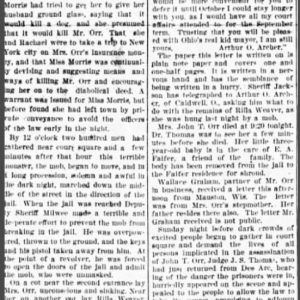calsfoundation@cals.org
Clarendon Lynching of 1898
On August 9, 1898, Manse (or Manze) Castle, Will Sanders (Saunders), Sanders’s mother Lorilla (Rilla) Weaver, Dennis Ricord (Record, Rikard), and Susie Jacobs—all African American—were lynched in Clarendon (Monroe County) because of their complicity in the murder of prosperous merchant John T. Orr. Rilla Weaver was the cook in the Orr household, and Susie Jacobs worked there as a maid. Rachael Morris, a “prominent young Jewess” who had also been implicated in the plot, escaped and was spared. Orr’s wife, Mabel, who had instigated the murder, lay fatally ill in the nearby jail, having taken poison; she was eventually to die in the jail. With her was the Orrs’ only child, three-year-old Neva. As horrifying as this story is, the details of it are reminiscent of a nineteenth-century melodrama, or perhaps a modern-day soap opera.
The story caused a sensation in newspapers across the country. The whole tale began to unfold when John T. Orr, then a “theatrical man,” clandestinely married Mabel Barker in 1890 in a small town in Wisconsin. Orr eventually left the theater, and he and Mabel moved to Clarendon, where he opened a prosperous hardware business and became a prominent citizen. Mabel, too, was much respected by Clarendon society. According to one account, “Mrs. Orr was admitted to the first homes of the town, given a prominent place in church work, and showed every consideration generally accorded good people.”
By all accounts, the Orrs had a rocky marriage. She claimed that he was abusive and had once struck her. They were both hot-tempered, and they argued frequently. On the night of August 5, Orr returned from choir practice (where his wife had been the organist) and went to the kitchen to make some lemonade. He was shot through the window by an unknown assailant. Bloodhounds were brought out for a search, but no one was found. (Apparently there had been another, earlier, attempt on Orr’s life when Dennis Ricord, who is described in many publications as a “hoo-doo doctor and conjurer,” attempted to poison him with boiled snake heads.) There were no further leads on the shooting until Rachael Morris, a young friend of Mabel Orr’s who had been living with the family, said that she knew who had committed the murder.
After a two-day inquest, seven people were charged in the crime. Mabel Orr apparently had instigated the murder when she said in the presence of her cook, Rilla Weaver, that she wished her husband were dead and would offer $200 if someone would kill him for her. Although Orr later said she did not mean it and had said it in a fit of temper, Weaver took her comment seriously and recruited another African American, Manse Castle, to do the job. Castle procured a gun with this intention and was originally thought to have fired the shots, but he claimed that he had had second thoughts and had given the gun to Ricord. Ricord, in turn, denied the charges and placed the blame back on Castle. Sanders, Rilla Weaver’s son, was ultimately charged with shooting Orr, and the others, including Mabel Orr, were charged with complicity.
Castle was arrested on Sunday night, August 7, and came very near to being lynched on the spot. According to the Wichita Daily Eagle, “the mob had already gathered to swing him up, and would have undoubtedly carried out their plan, but for the earnest appeal in behalf of law and order made by Judge Thomas who appeared on the scene just in time to prevent the lynching. He addressed the crowd, beseeching them to let the law take its course, and promised that the accused should have a speedy trial.” The others were arrested soon afterward, with the exception of Rachael Morris, who had fled. Some accounts say that Susie Jacobs also fled, and that only four people were hanged, but others, including an eyewitness report, maintain that she, too, was lynched. According to the Fitchburg, Massachusetts, Daily Sentinel, there were additional attempts to lynch the accused, but “each time the crowd dispersed on the promise of the officers to rush the trial without a change of venue, or any delay in the proceedings whatever.”
At midnight on the night of August 9, between 200 and 300 men stormed the jail and removed the accused African Americans. According to the Daily Eagle, “the mob was a most orderly one, not a word being unnecessarily spoken, and not a shot being fired.” They demanded the keys from Deputy Sheriff Patrick Milwee. He refused at first, claiming to have twenty-five guards at his back, but, “sensing their earnestness,” eventually gave in. The mob apparently bypassed Orr, as she was lying gravely ill and was being attended by a doctor after having taken poison. Indeed, the Daily Sentinel reports that it was the imminent death of Orr that spurred the mob to act when it did, and that “many of the mob favored taking her with the rest. Her death seems to be but a matter of a few hours. If she recovers it is stated that the mob will hang her.”
Sanders, Weaver, Ricord, and Castle were hanged from the tramway of the Halpern sawmill, which stood just behind the jail. Some sources indicate that signs were hung around their necks with the words “This is the penalty for murder and rape.” (The reference to rape was not explained in any of the accounts.) The eyewitness testimony of the telegraph operator in Clarendon, however, differs somewhat from these reports. His account, datelined Little Rock (Pulaski County), August 9, and published in the Sacramento Record-Union the following day, indicates that the bodies of Castle, Ricord, Sanders, and Jacobs were hanging from a tree “not far from his office,” while the body of “another negro woman, the former cook in the Orr household,” dangled from a tree “a few paces away.”
According to the Daily Eagle, “While the five bodies swung from the limb of a tree in the breeze the body of the widow of the murdered man lay rigid in death in her cell in the county jail with only the soft, sweet voice of her three-year-old child to break the silence of the gloomy jail, as the innocent little tot vainly cried for mama.” The bodies of the victims had not been cut down by 9:00 a.m. the following day and, according to the New York Times, “Great crowds viewed the gruesome sight of a woman and three men dangling six feet from the ground with tongues protruding and ropes cutting deep into their necks. The negroes seem to indorse the lynching, and many of them are open in their expressions of satisfaction over the death of Dennis Record, whose arts of hoo-doo and conjuring made him an object of dread and fear to them.”
During the next few days, ever more lurid details came out about the crime. It seems that Mabel Orr and Morris were planning to wait in Clarendon until Orr received the payout from her husband’s $5,000 insurance policy. They were then planning to go to New York and organize a theater company. It was also revealed that Orr had been writing to at least one man, Arthur O. Archer, the mayor of Caldwell, Ohio, using the name of her cook, Lorilla Weaver. A letter was discovered from Archer to Weaver, with Archer’s photograph enclosed. Archer at first denied any knowledge of such a correspondence, but later he admitted it. According to the Atlanta Constitution, yet another correspondent, to whom Orr had sent a photograph of herself and Morris, was discovered in Monroe County, Kentucky.
On August 11, while the bodies of the lynching victims were being “buried across the river,” Orr’s last wishes were revealed to the press. In her statement, she asked her elderly father, W. C. Barker of Mauston, Wisconsin, who is described as being “very low and in destitute circumstances,” to bury her body and to raise her young daughter, Neva. (Some sources reported that Barker lived in “Manston,” Wisconsin, but the proper location is Mauston, located seventy-three miles north of Madison.) She gave all her worldly goods to Neva, in care of the local Knights of Phythias lodge, of which her husband was a member. According to the Naugatuck Daily News, Orr also asked that“God will forgive Rachel (Miss Morris) for the way she has treated me.”
The Atlanta Constitution revealed the final macabre chapter of this story on August 11: “The third act in the Clarendon tragedy is as remarkable as the two preceding ones. Today the corpse of the murderess lies in the courthouse, while hundreds of people pass and view the remains. This unusual thing was done by the authorities to still the suspicion that Mrs. Orr was not dead, but had been spirited away. So strong had this feeling in the community become that this means was regarded as the only way to allay it.” The report also noted that a coroner’s jury had met and rendered a verdict that “the deceased negroes were killed by unknown persons.”
Speculation continued in the newspapers as to the location of Rachael Morris. On August 13, the Atlanta Constitution speculated that she might be either with relatives in Newport (Jackson County) or Augusta (Woodruff County), or with her grandfather in Nashville (whether Arkansas or Tennessee was not specified). On August 18, the Adams County Free Press of Corning, Iowa, hinted that she might be the unidentified white murderess incarcerated in Pine Bluff (Jefferson County). No definitive information on her whereabouts was ever given, however.
For additional information:
Buckelew, Richard. “The Clarendon Lynching of 1898: The Intersection of Race, Class, and Gender.” In Bullets and Fire: Lynching and Authority in Arkansas, 1840–1950, edited by Guy Lancaster. Fayetteville: University of Arkansas Press, 2018.
“The Clarendon Lynching.” Daily News (Naugatuck, Connecticut), August 12, 1898, p 1.
“Four Dead.” Arkansas Gazette, August 11, 1898, p. 1.
Holloway, Doug. “Clarendon’s Darkest Hour Revisited.” Central Delta Historical Review 3 (March 1999): 31–38.
“Hunting for Miss Morris: Clarendon Girl Mixed Up in Orr Assassination Still at Large.” Atlanta Constitution, August 13, 1898, p. 4.
“Lynchers of Women.” Wichita Daily Eagle, August 11, 1898, p. 6.
“Mob Avenges Orr’s Death: Four Negroes Taken from Jail and Lynched in Arkansas.” New York Times, August 11, 1898, p. 5.
“Mrs. Orr’s Statement Given: Wife of the Assassinated Arkansan Disposes of Her Effects.” Atlanta Constitution, August 12, 1898, p. 2.
“Quadruple Hanging.” Daily Sentinel (Fitchburg, Massachusetts), August 11, 1898, p. 8.
“Wholesale Lynching.” Record-Union (Sacramento, California), August 10, 1898, p. 8.
Nancy Snell Griffith
Presbyterian College


 Clarendon Lynching Article
Clarendon Lynching Article 



Comments
No comments on this entry yet.